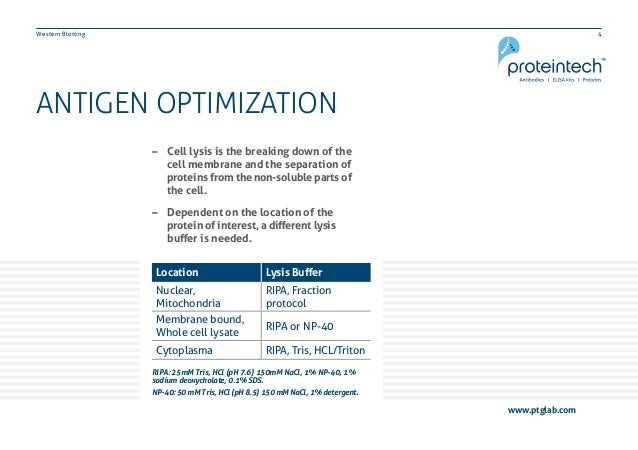

Methanol removes SDS from proteins and methanol can be reduced to 10% in the transfer buffer to discourage precipitation of proteins. Keep in mind though that SDS can inhibit membrane binding. You can try adding SDS to the buffer to a final concentration of 0.1%. Large proteins tend to precipitate in the gel SDS binds to proteins and inhibits precipitation. Alcohol and SDS have opposing effects on proteins and their migration out of the gel and ability to bind to the membrane. Change the composition of your transfer buffer.Use a chart to determine the correct percentage gel to be using for the molecular weight of your protein. A lower percentage gel will also resolve higher molecular weight proteins more accurately. Low percentage gels are difficult to work with because they tear easily, but proteins will migrate out of a lower percentage gel more easily than a higher percentage gel. Many people routinely set up the transfer apparatus in a cold room and transfer overnight. But you must make sure you keep things cool to prevent heating of the buffer. When using wet transfer systems and traditional transfer buffers, lower the voltage and increase the transfer time. You might have to use a few tricks to induce them to leave the cozy gel and bind to the membrane. High molecular weight proteins are notoriously difficult to transfer.
Western blot transfer troubleshooting how to#
If you are pretty sure that you haven’t made a colossal “silly” mistake, then the next step is to look carefully at your protein to determine how to optimize transfer. However, if you are working with small proteins, you have to be mindful that nitrocellulose comes in 2 different pore sizes: the 0.45µm pore is used for proteins greater than 20kDa, while the 0.2µm pore size should be used for smaller proteins. Did you use the right membrane? Most of the time you can use either nitrocellulose or PVDF membranes.Did you use the correct buffer for transfer? It can be easy to grab the wrong buffer – and let me tell you, your proteins aren’t sticking to your membrane without the right buffer in place.Did you reverse the polarity? Leads are easily swapped and connected wrongly, leading to the migration of your protein into the buffer tank rather than onto the membrane.Did you set the transfer up correctly? One of the most common mistakes is setting up the stack such that proteins will be transferring into filter paper rather than onto the membrane.Now mentally take yourself through your procedure and make sure you did the big things correctly: We all make them, let’s just admit to that.

The easiest problem to solve, but perhaps the hardest to admit to, is a seemingly stupid mistake. Rule out the silly mistakes with Western blot transfers

If you do have a transfer problem, you can try a number of things to resolve the issue. Once you have checked the membrane, you can easily rinse the dye off the blot and proceed with the Western. In this case, you can stain the membrane with a reversible protein stain such as AdvanStain Ponceau. However, sometimes the markers can transfer more easily than the average protein, or you might want to check transfer across the entire membrane. Seeing these marker bands on your membrane is a good sign that your transfer worked. Many labs use prestained molecular weight markers that transfer to the membrane. To determine whether it is a transfer issue, you need to check your transfer efficiency. First things first – make sure you have a transfer issueĪny number of things can go wrong during the Western blot procedure that will result in little to no signal. Unfortunately, this problem is often only realized after performing the entire Western blot procedure and ending up with no visible signal or only the faintest hint of bands after agonizingly long exposure times.įortunately, if you are certain the problem is due to inefficient transfer, there are several parameters you can tweak to “encourage” your proteins to migrate and stick to your membrane. One of the most frequent problems when transferring proteins to a membrane is inefficient transfer of protein. One might say you should start at the beginning, so why don’t we start with troubleshooting Western blot transfers? Transfer conditions, blocking buffers, primary and secondary antibody titrations – there are so many things that can be adjusted! Troubleshooting and optimizing Western blots can eat up a lot of your time.


 0 kommentar(er)
0 kommentar(er)
